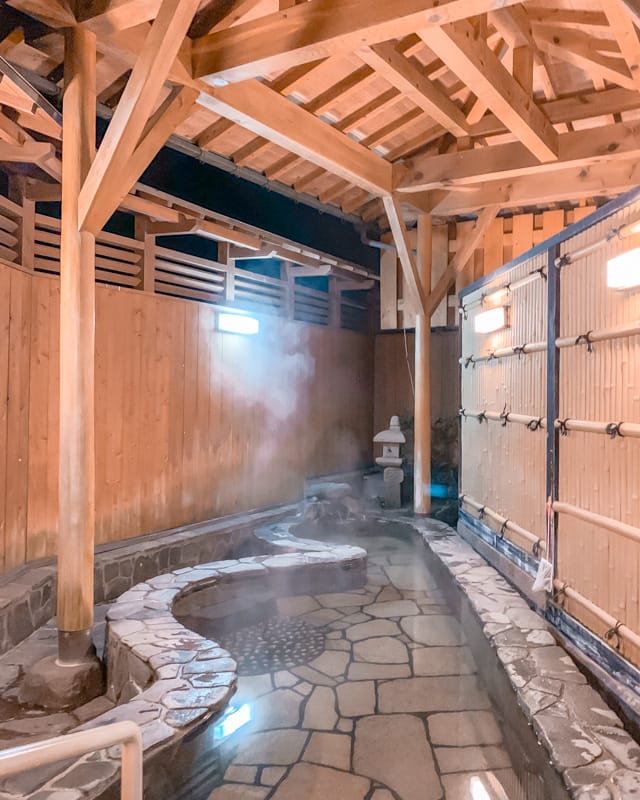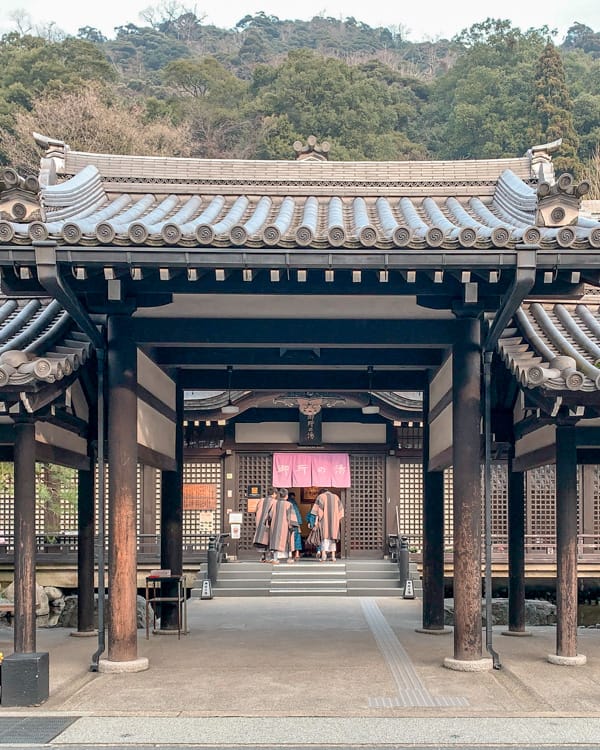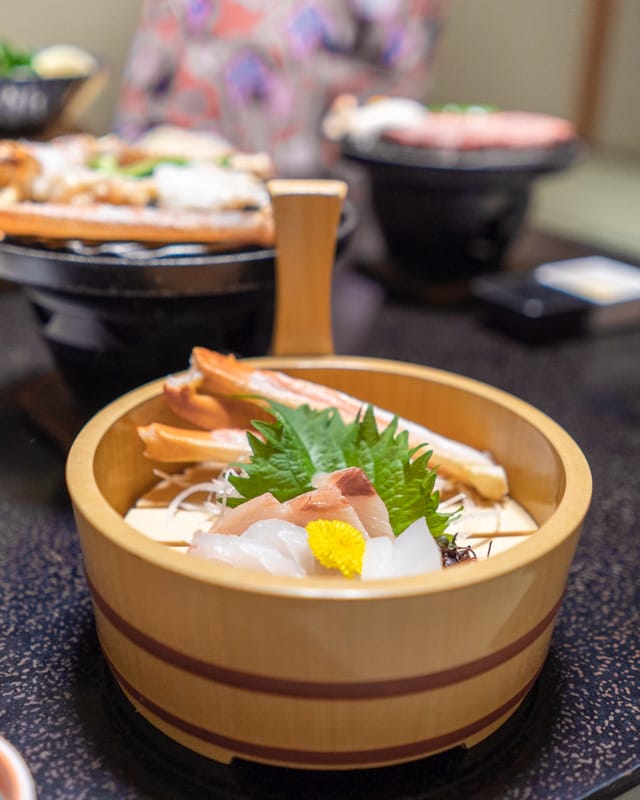
Close to Kyoto, we visited the untouched, old-world charm of Kinosaki Onsen. A perfect overnight trip from Kyoto or Osaka. It’s one of the best onsen towns that’s 1,300-year-old, located north of Hyogo Prefecture. Famous for its hot springs, we enjoyed a relaxing night at Kinosaki onsen for a unique experience of Japanese culture.
I was so excited to be enjoying my first ryokan experience! It’s a traditional Japanese style inn, which originated in the Edo period (1693-1868). The best way to enjoy it is by enjoying the seven public baths. It’s also great for foodies to taste the specialty foods of the delicious Tajima Beef and Matsuba crab.

Table of Contents
Stay at a ryokan
As soon as we arrived, we passed the Otani River which runs through the centre of the town. It seems as though this town is ‘Preserved in time’, charmed with traditional architecture and ryokans. This town is filled with many ryokans, we stayed at Kinosaki Onsen Higashiyamasou which have traditional rooms filled with tatami floors (woven straw mats), wooden infrastructure and sliding door guest rooms.
We arrived early evening and checked-in to our ryokan for the night. Then explored the streets in a kimono. The place we stayed at provides kimono dressing and hire. Not very practical but a great photo opportunity ?
→ More: Overnight temple stay at Mt Koyasan
Natural Hot Spring Bathhouses
Surrounded by mountains and sea, Kinosaki Onsen is home to seven unique public baths. It’s built around a sacred natural hot spring with temperatures of 80ºC and then regulated at the bathhouse to around 42ºC. Its waters contain a wealth of minerals such as sodium, calcium and chloride. The heat and natural minerals soothe the body and soul, which have increased health benefits. It is said that each hot spring offers different benefits depending on the minerals in the water. Relaxing in the onsen soothes the muscles, helps reduce fatigue and boosts the metabolism.
All guests staying in a ryokan can receive a free onsen pass, we received our pass upon check-in. This pass has a code which we used to access all the onsens and is valid until 10am the next day. Alternatively, if you are only visiting for the day, the price of the one-day pass is 1,200 yen for adults, 600 yen for children and free for children under 3-years-old. (*prices at the time of post)

From our ryokan, all seven onsens were conveniently located. Each onsen is within walking distance to each other, and some are closed on certain days, so be sure to check in advance. The one I wanted to try and outdoor onsen, Goshono Yu, but was closed on Thursday when I visited. Choose from the larger bathhouses Satono Yu (outdoor), Goshono Yu (outdoor) and Ichino Yu (cave-like) are spacious or the smaller ones of JIzou Yu, Yanagi Yu, Kouno Yu (open-air) and Mandara, which is popular amongst the locals.
Kinosaki is tattoo friendly so those visitors can enter and enjoy all the seven onsens. Though usually it’s prohibited to enter for those who have a tattoo, so there is no need to worry in Kinosaki.
→ More: Overnight temple stay at Mt Koyasan
If you are not keen on the public bath, onsen, some ryokans have private onsens available. Upon check-in at our ryokan, we were able to book a private onsen to experience for up to 40 minutes. There are two private open-air baths available, which are usually first come first serve basis. It was the perfect way to end the night, I relaxed in the outdoor onsen under the starlit night sky.
Tip: remember to drink heaps of water!
Onsen culture
Immerse yourself in the onsen culture by taking a pleasant stroll along the streets wearing traditional Japanese spa wear, a Yukata. Also, known as sotoyu meguri, a public bath stroll. Our ryokan provided both Kimono and Yukata included, so we also enjoyed a stroll in both. Most ryokans offer Yukatas to their guests, each ryokan has its unique Yukata design, you’ll be able to spot those staying in the same ryokan as you. The yukata is very comfy to wear and is convenient and easy when visiting bathhouses.
Tip: most onsens close around 11pm with last entry at 10:45pm.
Onsen etiquette
When entering an onsen, scan you onsen pass or pay the entrance fee at the front desk. After take off your shoes and place them in one for the shoe lockers at the front. You are then ready to enter the change rooms, there is a separate bath area for men and women. The colour codes are red for women and blue or purple for men.
Inside you’ll find a locker to place your items and undress (note: bathing suits are not permitted). Those entering the onsen, rinse your body at the showers before entering the onsen bath. Don’t let your hair or towel touch the water as it’s considered rude and unclean. Relax and enjoy.
→ More: Discover Hakone: a day trip from Tokyo
Dinner – Kaiseki style (food specialties Tajima beef and Matsuba snow crab)
As the night falls, we head back to our ryokan for dinner served in our rooms. Our package included dinner and breakfast, both we delicious! For dinner, we had Tajima beef and snow crab in kaiseki style, a multi-course meal. One bite of the Tajima beef just melted in my mouth, packed with rich flavours and superior texture. Its high marbling is a different cut from selected Tajima cattle for Kobe beef. My next bite of Matsuba crab was so sweet and fluffy, I enjoyed every bit. It’s the local male snow crab from the Sea of Japan. Both of these are a specialty in the area and are not to be missed when visiting. We also had the Chawanmushi which is Japanese steamed egg custard. After dinner our rooms we transformed for bed and set up with futons.
Note: the specialties of snow crab season is between November to March.

Evening stroll
After dinner, dressed in a yukata, I went out for an evening stroll to explore Kinosaki at night. The streets lit with a warm glow of the street lights and lanterns along the river. As I explored the town and visited the various onsens, I could hear the chime of the clit clattering of geta (wooden sandals) that echo throughout the town. There were old-school arcades dotted along the streets of cork gun shooting games and pinball machines.
→ More: Discover Hakone: a day trip from Tokyo

Morning breakfast
In the morning for breakfast, we woke up to a delicious Japanese style breakfast served in our rooms. We had generous portions of assorted dishes including tofu, grilled fish, rice, pickles, miso and my favourite, Japanese-style omelette. It’s the best ways to start the morning.

Enjoy a Public onsen foot bath
Spotted along the streets, between the various onsen houses are steaming hot public foot baths. We stopped on the side of the street near the Kinsaki Onsen Ropeway and dipped our feet in for a relaxing soak.
Kinosaki Onsen Ropeway and Onsenji Temple
After we headed to the top of Mount Daishi for the panoramic views of the city and the Sea of Japan. Halfway up the mountain, we stopped to visit Onsenji Temple (温泉寺, lit. “hot spring temple”) which has stood since 738 A.D, and was once customary to pay respect here before entering the hot springs. The temple was founded by Dochi Shonin in 738 and within is a two-meter-tall, eleven-headed Kannon Buddha. The Buddha is called Juichimen Kanzeon Bosatsu and means “11-faced goddess of compassion and mercy”. Designated a national treasure, the Buddha is visible to the public only once every 33 years for 3 years. We were lucky enough to see the Buddha within the 3 years; it is visible to the public. It is currently being displayed from April 23, 2018, to April 24, 2021 (ref from Japan Guide).
The Kinosaki Onsen Ropeway is 7 min ride to the top or a 20min hiking trail to the middle station. The ropeway operates from 9:10am to 5:10pm.
→ More: Overnight temple stay at Mt Koyasan
Genbudo Park
Next, we visited The Genbudo cave, it is formed from a massive basalt formation, cooled magma of the volcano which erupted 1.6mil years ago. Recently designated a UNESCO site, it contains five caves. We visited the 2 main caves, the Genbudo Cave and Seiryudo Cave.
Katsu curry rice
For lunch, we went to Tajima Beef Irori Dining Mikuni for their speciality of Tajima beef. One of their recommendations is the Tajima Beef Steak Set. We tried one of the other dishes Tajima beef curry set. A delicious taste that just fills my mouth. This place can be quite popular so expect a queue. Unfortunately, they don’t accept bookings for lunch but is recommended for dinner.
Onsen drinking fountain
Before our train back to Kyoto, we spotted an onsen drinking fountain near the train station. We asked our guide if it was safe drinking water and she said it was. I wasn’t sure what taste to expect, so I decided to give it a try. I didn’t quite like the taste, but the water helps to relieve constipation and digestive issues.
Where is Kinosaki? How to get to Kinosaki Onsen Town
We took a train back into the Kyoto city, Kinosaki is 2.5 to 3 hours by train
Use your Japan Rail Pass to easily get to Kinosaki from Kyoto or Osaka via Japan Railway trains for no additional cost.
JR Kyoto to Kinosaki Onsen (2 hours, 30 minutes)
JR Osaka to Kinosaki Onsen (2 hours, 40 minutes)
JR Kobe to Kinosaki Onsen (2 hours, 30 minutes)
JR Himeji to Kinosaki Onsen (1 hour, 50 minutes)

Happy Travels
Kinosaki Onsen was an unforgettable traditional Japanese experience. Filled with culture, history and amazing food. Home to specialties of Tajima beef and Matsuba snow crab. It’s definitely worth a trip! Happy Travels xx
Follow along to my next adventure to Mount Koyasan for an overnight temple stay!




















